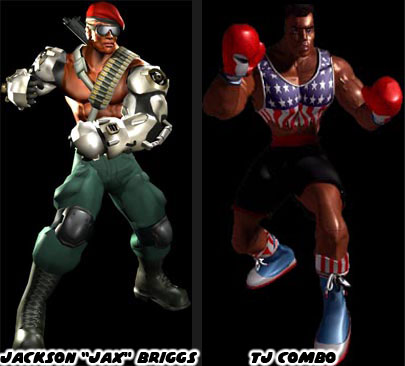
Actual paraplegic fighters had very rarely been done in gaming. In cinema there had been plenty of drunken and blind masters but those with real or imaginary physical deformities were rare. Possibly the most famous of the real-life kung-fu exploitation films was the Crippled Masters. The film from 1979 featured Chen Mu Chuan, Jackie Conn and Frankie Shum, two of the actors were actually born with deformities. The film told the story of a Shaolin monk that teaches a person born with no arms, and a person with deformed legs, how to use kung-fu in order to beat a local crime boss. It so happened that the crime boss was a "hunchback" with deep facial scars. The villain actually had a metal plate covering his deformity. It was a unique premise but with an absurd "team up" ability. The duo has a backpack that allows them to fight back-to-back.
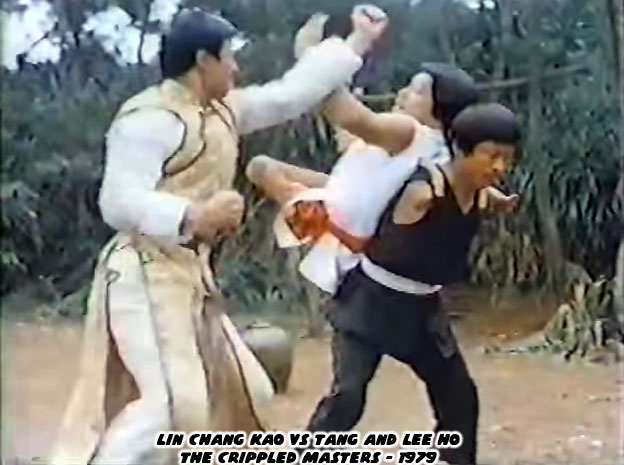
In fighting game history there was actually a character that was similar to the Crippled Masters. The villain Twin Tartars appeared in the game the Killing Blade. The 1998 title by IGS appeared on their PGM arcade system. Both fighters had flaming swords that they used in combat. The larger of the fighters was blind and the smaller had achrondoplasia. He was a little person, someone that may be mislabeled a dwarf. The smaller brother rode on the shoulders of the larger and helped direct the attacks. There was a more recent character that was in a similar vein. Ferra and Torr appeared in Mortal Kombat X. The game came out in 2015 yet the idea of a smaller character controlling a larger fighter was at least 30 years old. The design could be traced back to the film Mad Max Beyond Thunderdome. Released in 1985 it was the third film in George Miller's Mad Max series. In the film the warlord that controlled Bartertown was called Master Blaster. Master was a little person that rode on the shoulders of an enormous warrior "Blaster" who was actually a young man with down syndrome. People with cognitive disorders or impaired development were even less likely to be featured in any form of popular entertainment. It was one of many bold ideas that Miller brought to cinema and it helped color the design of other films as well as fighting games.
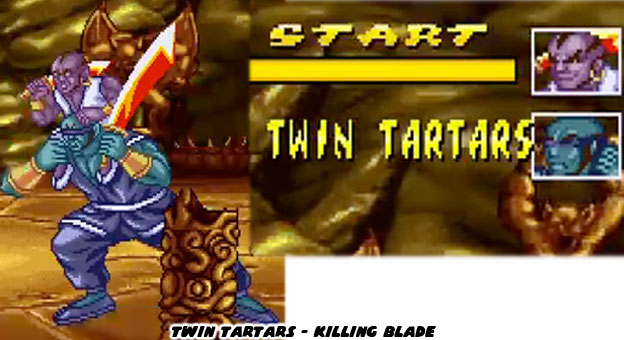
Killing Blade was notable because it had more characters with physical challenges than any other fighting game ever made. The Twin Tartars were non-playable boss characters in the story mode. One of the main characters that players could use was just as unique as the bosses. Zhuge was a one-armed swordsman. He was driven for revenge but by the end of the game he realizes that no amount of bloodshed would bring back his loved ones or his arm for that matter. He accepted this and became a wandering sword for hire, content with his jug of wine. If anything he had the temperament of Haohmaru, the star of the Samurai Shodown series.
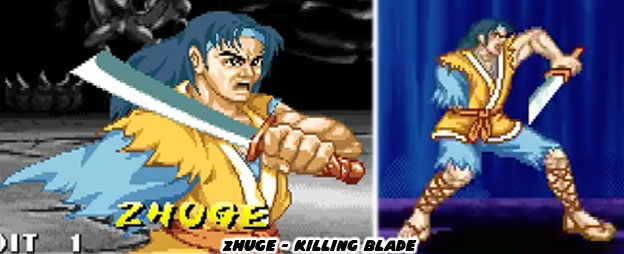
The one -armed swordsman was a character that was made popular more than a generation ago. Jimmy Wang Yu was a young writer / action film star that appeared in a movie called the One Armed Swordsman. The title from 1967 introduced us to a melancholy fighter. It became a big hit in Asian markets and a sequel soon followed. The films gave Wang Yu the traction to leave the famous Shaw Bros. Studio and strike out on his own. In 1971 he released a variation of the movie titled the One Armed Boxer. I had written about this influential person in a previous blog. The movies featuring Jimmy not only influenced other action films but they also planted the design seeds of fighting games, not the least of which was the Street Fighter series. His one armed characters were very well done. They were interesting and sympathetic characters.
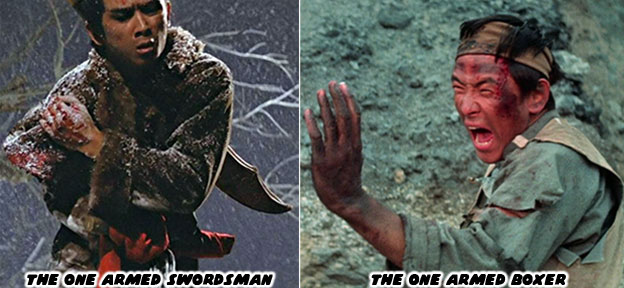
One of the action film stars influenced by Jimmy was Donnie Yen. Donnie like many of his contemporaries had grown up watching the movies and learning the legends of the various martial arts heroes. Donnie decided to write, direct and produce a love letter to the classic films. He called his 2011 movie WuXia, which was the Chinese word for martial arts myth. In the film Donnie played Tang Long, an assassin that was wanted to escape his brutal past. He married and had a child and moved to a village in the country. A botched robbery brought him out of hiding and made it so his old gang was able to track him down. In a last ditch effort to leave the gang he tries faking his own death and even cuts off his own arm in a symbolic gesture that he has quit the gang. I don't want to bore you with the details but I will mention that Donnie managed to get Jimmy Wang Yu out of retirement to play the leader of the 72 Dragons and father of Tang Long. The fight choreography was superb and it really demonstrated what was capable by using only one arm in battle.
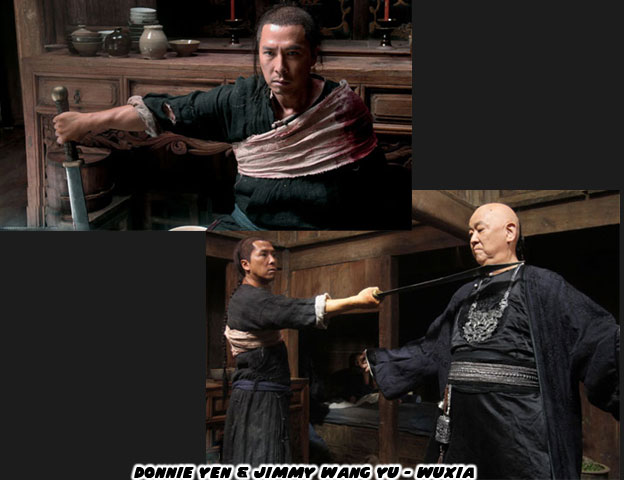
Zhuge was a variation of the One Armed Swordsman, combined with elements from other films. As great as it was having an amputee represented in a fighting game, it also pointed out one glaring issue with sprite-based technology. Namely the issue of sprite mirroring. Animators working on sprite-based titles only had to create character art facing one direction. The programmers would simply mirror or flip the image so that they could face the opposite direction in game. This was perfectly fine for the vast majority of fighting games because players had full use of both arms and legs. When The Killing Blade came out this limitation was obvious. Zhuge would have the wrong arm missing when he faced the opposite direction. It was a minor detail and most audiences didn't seem to mind this.
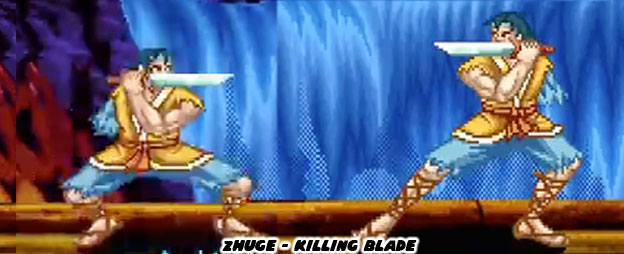
The limitations in technology throughout the '80s, specifically with memory, were responsible for sprite mirroring. Designers had to carefully plan out costumes for their main characters that required few colors and little detail. They tried to limit the details that would give away the mirroring effect, such as patches or words that would end up backwards. When the game came out many Street Fighter II fans noticed that Guile's USA flag tattoo was reversed when he faced the opposite side. Not every studio took the time to review these details, a few got past Capcom but not enough to be noticeable. When sprite-based engines improved in the '90s then the ability to create larger, more colorful and more detailed sprites took over. Capcom showed off their CPS-3 hardware with the games Warzard (Red Earth) and Street Fighter III. To show how much the engine had advanced they decided to create a boss that would take advantage of this new technology. The final boss of Street Fighter III, Gill, was not a mirrored sprite. He had a left and right side, the right side was made of fire and the left made of ice. That little detail remained correct regardless of what side of the screen he was on. His attacks even showed off this detail, he could burn or freeze opponents depending on which arm or leg he struck with.
In the planning stages Gill was not the only character that was supposed to have a left and right side. One of the early concept characters for the "New Generation" was a one-armed fighter. Somebody that could be likened to the one-armed boxer from the Jimmy Wang Yu movies. The artists, specifically Akiman and Kinu Nishimura looked at Helio Gracie, the co-founder of the Gracie Ju-Jitsu system as the root of this new character. The figure would evolve and become Oro. The developers realized that while they could create a left and a right-side version of this fighter that in order to be accurate he would actually have to have his back to the player. This was an aesthetic challenge. The ability to "read" the character was very important to players. The competitive game players would have their rhythm thrown off if they could not see a leading hand or foot, Casual players would not be able to appreciate the design of the character if all they saw was a back. Capcom had to figure out a way to present the "crippled" boxer while also using sprite mirroring. It was decided that Oro would simply tuck his arm behind his back depending on which side he was facing. It made sense and was accepted by audiences. Just remember that for a brief moment the designers at Capcom were considering including an amputee in the lineup. How interesting would that have been?
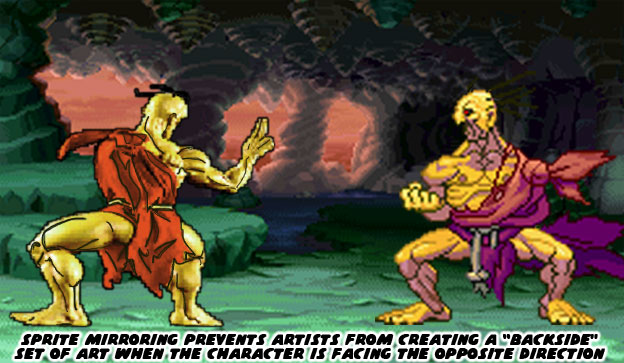
The Taiwanese designers at PGM didn't think twice, they actually put a swordsman with only one arm in their game. More important they had another playable character that had an even greater physical disability. The character Tsan was legless. His long white hair and green skin made him appear like a demon. Many game players assumed that he was indeed some sort of supernatural creature. The game was poaching many of the ideas and themes explored in SNK's Samurai Shodown series, including the mystical elements. Yet instead of feudal-era Japan this game was set in ancient China. Tsan wielded two swords and actually "walked" around on the tip of his blades. He could hurl himself at players, leap across the screen and pretty much moved like a ghost.
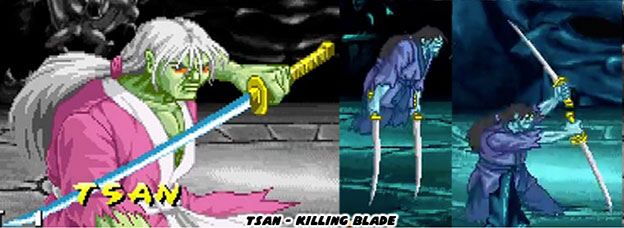
As the plot was revealed it turned out that Tsan was a living sword master and not some sort of ghoul. He had overcome his disability and learned various two sword techniques. The fact that he was lighter without his legs allowed him to move much faster than a normal person. When this was combined with his looks it was easy to see why people thought he was some sort of monster. Tsan was actually a positive character. He was such an accomplished fighter that he had actually taken on pupils. When the evil of the Twin Tartars and a corrupt emperor were defeated he decided to go into retirement. The Taiwanese developer had done a great job at creating heroes and villains with different backgrounds. The fact that they included disabled fighters was one of their more unique contributions to the genre.
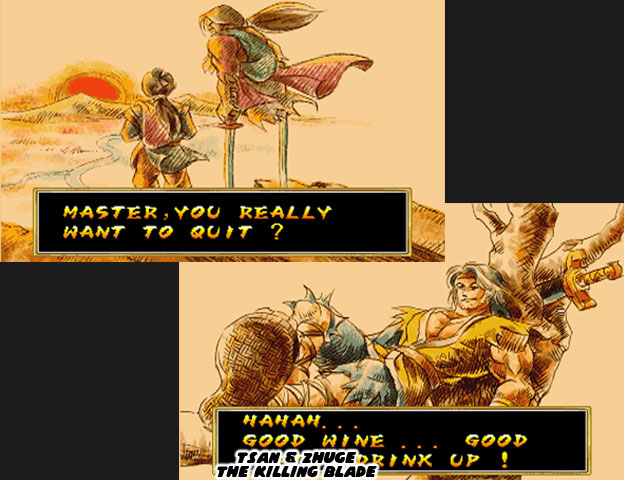
What are your thought on fighting game characters with different backgrounds and abilities? Who were some of your favorite non-traditional fighters? I'd like to hear about it in the comments. As always if you would like to sponsor me please visit my Patreon page and consider donating each month, even as little as $1 would help make better blogs and even podcasts!

No comments:
Post a Comment